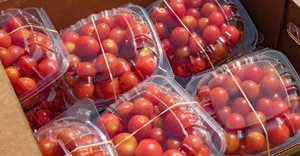Red 35-gallon containers with “compostables” imprinted on the top and sides stand out on the curbsides of North Liberty, Iowa. Johnson County Refuse, which launched the residential pickup, hopes the unconventional color will draw attention to its fledgling food scrap collection that costs $1.65 for each large compostable bag.
Elsewhere, the coastal town of Newport, Ore., rolled out its opt-out organics recycling program to its 10,000 residents in July 2014. Residents pay $6.59 monthly for a 95-gallon cart to collect their food scraps, paper towels and woody debris.
Meanwhile, an average of 13 pounds of food waste is collected from each of the more than 1,500 households participating in Takoma Park, Md.’s free program that was expanded from a small pilot to all city residents last year.
These are just a few examples of the coast-to-coast trend of municipalities piloting and implementing residential food waste collection programs, says Leanne Spaulding, director of membership and communications at U.S. Composting Council.
“We have been working very closely with members in a number of states, some of those have passed bills that are going to implement aggressive food scrap collection programs or strengthen ones that currently exist and we have seen a number of states start to consider similar legislation which is great,” says Spaulding, adding the council’s “model compost template” was adopted by the state of Tennessee and also is used in Maryland and Minnesota. “I use the flurry of legislative activity as my benchmark and we saw a lot of activity in 2014.”
According to a nationwide survey by BioCycle magazine, close to 200 municipalities offer residential food collection—up more than 8 percent from its 2012 survey count.
“Legislation has been the biggest driver, especially in the New England region in the last two years,” she says. “One of the major roadblocks for greater participation nationwide is lack of infrastructure.”
For example, the biggest challenge for Takoma Park has been stable processing, says Daryl Braithwaite, public works director for the Maryland city, which uses the Prince Georges County food waste composting facility.
“I think we are on our third or fourth vendor,” she says. “The only other problem we have had is theft of the collection containers when they are left at the curb.”
The city has had an active and aggressive waste diversion program since the early 1990s.
“We have been interested in food waste collection and composting for years, but were waiting for sufficient processing infrastructure to get established so we would have a place to take our materials,” she says. “In 2012, we started a program and used a private composting facility located in south Baltimore. As soon as the processing infrastructure was available we developed our program.”
North Liberty, a suburb of Iowa City, faces the opposite problem. The infrastructure is there—ready and waiting for residential interest, says Steve Smith, owner of Johnson County Refuse. His company has been doing commercial composting for years, picking up food waste from the University of Iowa and other businesses around town before expanding its collection program to residents last year.
The private company revamped its yard waste collection program to create a seamless and easy transition for residents interested in diverting their food waste from the landfill.
“We buy the containers and they put a deposit down. Then they buy one of our brown yard waste bags which have ‘Johnson County Refuse’ printed on it. That goes as a liner in the container and it’s the same one we use for yard waste in town,” Smith says.
The company currently collects food waste from slightly more than 60 residents out of 6,000 houses in the community. “It’s not a whole lot but I think it will catch on as it goes,” he says. “The refuse is a volume-based system and when my family started composting at our house, we cut our garbage way over half right off the bat.”
Smith’s personal example is exactly what Mark Saelens, program manager of Lincoln County Solid Waste District, hopes to see happen in Newport.
“The idea is by removing food waste from your normal garbage, you should be able to move from a 35-gallon trash cart to a 25-gallon cart for basically the same fee you were currently paying,” say Saelens, who admits a larger percentage of residents opted-out of the city’s program than expected. “We also had higher utilization of the carts that are out there. Believe it or not, we had a lot of people in the program who, at the start, thought they wouldn’t use it and are now devoted to it.”
About the Author(s)
You May Also Like


